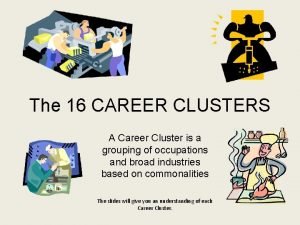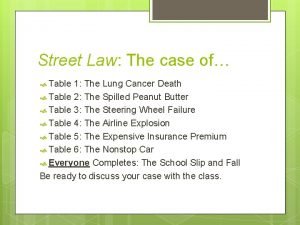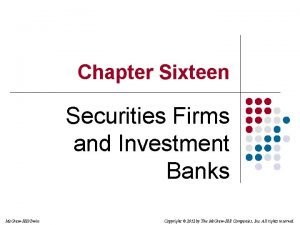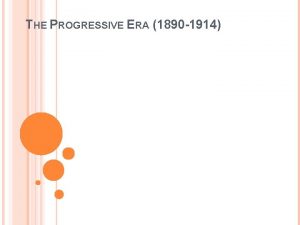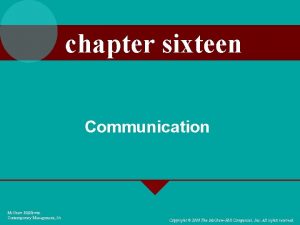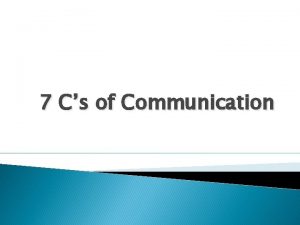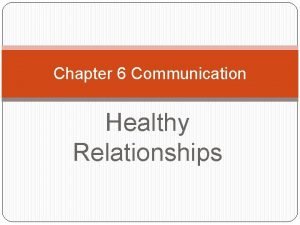Chapter Sixteen Promoting Effective Communication Mc GrawHillIrwin Copyright











![Face-to-Face Communication Ø Management by [walking] around is face -to-face technique in which a Face-to-Face Communication Ø Management by [walking] around is face -to-face technique in which a](https://slidetodoc.com/presentation_image/dfd979fa1899f88f031d1cd200f3c447/image-12.jpg)









- Slides: 21

Chapter Sixteen Promoting Effective Communication Mc. Graw-Hill/Irwin Copyright © 2009 by The Mc. Graw-Hill Companies, Inc. All rights reserved.

Communication and Management Ø Communication ≈ The sharing of information between two or more individuals or groups to reach a common understanding. 16 -2

Communication and Management Ø Importance of Good Communication ≈ Increased efficiency in new technologies and skills ≈ Improved quality of products and services ≈ Increased responsiveness to customers ≈ More innovation through communication 16 -3

The Communication Process Figure 16. 1 16 -4

Verbal & Nonverbal Communication Ø Verbal Communication ≈ The encoding of messages into words, either written or spoken Ø Nonverbal ≈ The encoding of messages by means of facial expressions, body language, and styles of dress. 16 -5

The Role of Perception in Communication Ø Perception ≈ process through which people select, organize, and interpret sensory input to give meaning and order to the world around them ≈ Influenced by people’s personalities, values, attitudes and moods as well as their experience and knowledge 16 -6

The Role of Perception in Communication Ø Biases ≈ systematic tendencies to use information about others in ways that can result in inaccurate perceptions Ø Stereotypes ≈ simplified and often inaccurate beliefs about the characteristics of particular groups of people 16 -7

Information Richness and Communication Media Ø Managers and their subordinates can become effective communicators by: ≈ Selecting an appropriate medium for each message—there is no one “best” medium. ≈ Considering information richness § A medium with high richness can carry much more information to aid understanding. 16 -8

Information Richness of Communication Media Figure 16. 2 16 -9

Discussion Question 1 Ø Which medium to you think would be appropriate for each of the following kinds of messages that a subordinate could receive from his/her boss? ≈ A raise ≈ Not receiving a promotion ≈ An error in a report prepared by the subordinate ≈ Additional job responsibilities ≈ The schedule for company holidays for the upcoming year 16 -10

“its not u … : (“ Ø About 1 in 10 cellphone users 18 -34 have texted someone out of their romantic lives, according to 2007 survey ≈ Doesn’t include emailed kissoffs Ø Interpersonal relationships today often less personal and more cowardly than they used to be Ø See also dontdatehimgirl. com and ihateher. com Ø Motivational speaker who often appears before singles groups knows what it’s like to be dumped – he once dated a woman and things didn’t feel right; he asked her: “Is there someone else? ” She replied: “There’s got to be. ” Ø After getting dumped, 72% of people go online to search for other potential dating partners, according to 2007 survey of Yahoo!Personals users. Ø One woman dumped via text says: “Every computer and cellular phone needs a little instruction manual to let people know what can be sent in a text, what can be sent in an email, what can be said on the phone, and what must be said in person. ” Ø Source: Wall Street Journal, 2/14/07 16 -11
![FacetoFace Communication Ø Management by walking around is face toface technique in which a Face-to-Face Communication Ø Management by [walking] around is face -to-face technique in which a](https://slidetodoc.com/presentation_image/dfd979fa1899f88f031d1cd200f3c447/image-12.jpg)
Face-to-Face Communication Ø Management by [walking] around is face -to-face technique in which a manager walks around a work area and talks informally w/ ees about issues and concerns. 16 -12

Communication Networks Ø Communication Networks ≈ The pathways along which information flows in groups and teams and throughout the organization. 16 -13

Communication Networks Ø Type of communication network depends on: ≈ The nature of the group’s tasks ≈ The extent to which group members need to communicate with each other to achieve group goals. 16 -14

Organization Communication Networks Ø Organization Chart ≈ Summarizes the formal reporting channels in an organization. ≈ Communication in an organization flows through formal and informal pathways ≈ Vertical communications flow up and down the corporate hierarchy. 16 -15

Organization Communication Networks Ø Organization Chart ≈ Horizontal communications flow between employees of the same level. ≈ Informal communications can span levels and departments ≈ Grapevine - an informal network carrying unofficial information throughout the firm. 16 -16

Technological Advances in Communication Ø Intranets ≈ A company-wide system of computer networks for information sharing by employees inside the firm. 16 -17

Technological Advances in Communication Ø Groupware ≈ Computer software that enables members of groups and teams to share information with each other and improve communication and performance 16 -18

Groupware Ø Employees are likely to resist using groupware when: ≈ people are working primarily on their own ≈ people are rewarded for their own individual performances ≈ People are reluctant to share information 16 -19

Groupware Ø Collaboration software ≈ groupware that aims to promote collaborative, highly interdependent interactions among members of a team and provide the team with an electronic meeting site for communication 16 -20

Barriers to Effective Communication Ø Messages that are unclear, incomplete, difficult to understand Ø Messages sent over an inappropriate medium Ø Messages with no provision for feedback Ø Messages that are received but ignored 16 -21
 16 point compas
16 point compas It’s half past three
It’s half past three 16 career cluster
16 career cluster Jose trips over his untied shoelace
Jose trips over his untied shoelace Explain how securities firms differ from investment banks
Explain how securities firms differ from investment banks Glencoe health and wellness
Glencoe health and wellness Lesson 4 promoting health and wellness
Lesson 4 promoting health and wellness Chapter 7 promoting health and wellness
Chapter 7 promoting health and wellness Promoting bowel elimination
Promoting bowel elimination Chapter 13 distributing and promoting products
Chapter 13 distributing and promoting products Chapter 1 lesson 4 promoting health and wellness
Chapter 1 lesson 4 promoting health and wellness When was the progressive era? *
When was the progressive era? * Promote service arrange decide
Promote service arrange decide Promoting alternative thinking strategies
Promoting alternative thinking strategies Do. 27 s. 2015 promoting family earthquake preparedness
Do. 27 s. 2015 promoting family earthquake preparedness Promoting racial literacy in schools
Promoting racial literacy in schools Lesson 4 promoting health and wellness
Lesson 4 promoting health and wellness Philip curry business
Philip curry business Promoting infant health section 7-2
Promoting infant health section 7-2 Promoting excellence in dementia care
Promoting excellence in dementia care What is deontological ethics
What is deontological ethics Promoting services and educating customers
Promoting services and educating customers


